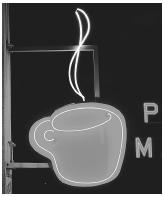Neon

MELTING POINT:
−248.59°C
BOILING POINT:
−246.08°C
DENSITY
: 0.8999 kg/m
3
MOST COMMON IONS
: None
Neon (from the Greek word neos, meaning "new") is the second lightest of the noble gases . It forms no stable compounds with other elements. Discovered in 1898 by Sir William Ramsay and Morris Travers during their experiments with liquid air, neon accounts for 18 millionths (18 ppm) of the volume of Earth's atmosphere. Trace amounts are also found in the oceans. It is present in the Sun and in the atmosphere of Mars.
At room temperature neon is a colorless, odorless gas. Upon freezing it forms a crystal with a face-centered cubic structure. In a vacuum discharge tube, neon emits its famous red-orange light, which has long been used in advertising signs and discharge display tubes. More recently neon (mixed with helium) has been used in common lasers and laser pointers, which produce a characteristic red neon spectral line corresponding to light of wavelength 632.8 nanometers (2.49 × 10 −5 inches).
Neon is produced within stars during nucleosynthesis . It has three stable isotopes , of which neon-20 is the most abundant (90.5%).

SEE ALSO Gases ; Noble Gases ; Ramsay, William ; Travers, Morris .
Richard Mowat
Bibliography
Lide, David R., ed. (2002). The CRC Handbook of Chemistry and Physics, 83rd edition. Boca Raton, FL: CRC Press.
Nobel Lecures in Chemistry 1901–1921 (1966). New York: Elsevier.
Comment about this article, ask questions, or add new information about this topic: